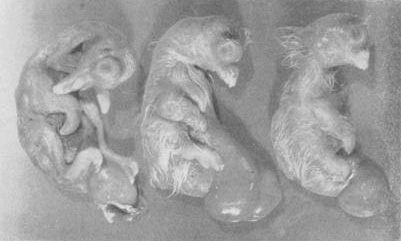
9. X-Pigeons |
||||
ac - Achondroplasia (lethal)
 Achondroplasia
also known as dwarfism is the skeletal disorder, characterized by
failure of normal conversion of cartilage into bone. Although achondroplasia,
a Latin word, literally means "without cartilage formation," the
defect in achondroplasia is not in forming cartilage but in converting
it
to bone, particularly in the long bones.
Achondroplasia
also known as dwarfism is the skeletal disorder, characterized by
failure of normal conversion of cartilage into bone. Although achondroplasia,
a Latin word, literally means "without cartilage formation," the
defect in achondroplasia is not in forming cartilage but in converting
it
to bone, particularly in the long bones.
In an article written by Doc. W. F. Hollander named "lethal achondroplasia in the pigeons", dwarfism found in pigeons as a recessive sex-linked lethal condition, where the embryo never hatches to survive, hence known as the lethal gene. Although W. F. Hollander admits that further scientific research needs to be done for lethal achondroplasia in pigeons, it is apparent that it does exist in pigeons.
According to Hollander, the embryos demonstrated on the left picture found to be uniquely abnormal. None of the three embryos succeeded in breaking the eggshell; in fact, there was no indication that even an attempt was made to break the shell. Left: a normally proportioned embryo: center and right, achondroplastic embryos, male and female.
Failure to draw in the yolk sac is a general symptom of embryonic weakness. (Down of the achondroplastic embryos is normal while the other embryo is genetically short-downed.) All these embryos had very short limbs and beak, about half normal length, like the ones illustrated in the picture. Dissection revealed that both sexes were represented, and no abnormalities of any internal organs were seen. Since the skeletal system seemed most effected, the term achondroplasia is used to designate the condition. It seemed probable that the achondroplastic type was a hereditary lethal, rather than an affect of nutritional deficiency or other environmental influence.
Achondroplasia can be carried as a recessive (hidden) gene for generations and never show itself until both parents who are heterozygous for achondroplasia (carrier of dwarf gene) is mated and both donated the lethal achondroplastic gene to their offspring. Notice I said, heterozygous parents carrying achondroplasia, because a homozygous achondroplasia pigeon embryo never hatch and survive. The only way to find out if the parents are carriers of achondroplastic gene is when we examined the unhatched embryos as illustrated in the above pictures.
A lot of breeders think they might have a dwarf pigeon in their loft because they have extremely short legs or very small feet or stubby toes. Some birds are also a lot smaller than the rest, and the breeder may assume it is caused by dwarfism. However, according to genetics expert W. F. Hollander, achondroplasia (dwarfism) in pigeons is lethal and the babies die in the egg before seeing a daylight.
References:
1. Hollander, W. F. (1945).
Lethal Achondroplasia In The Pigeons. Journal of Heredity Volume
36, Issue 10 Pp. 297-300.
2. Hollander, W. F. (1983). Origins And Excursions In Pigeon Genetics: A Compilation.
Burrton, Kan.: The Ink Spot.
Copyright April, 2011 by Arif Mümtaz